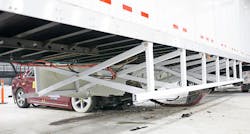2022 regulations outlook: After a slow 2021, feds could be busy next year
This is the first of a two-part FleetOwner look at trucking industry-related regulations that will go into effect or could be on the horizon in 2022. Read part two here.
After the Democrats won the White House and control of Congress in 2020, it was expected the party would come into Washington looking to undo much of the Trump-era regulations and deregulation. But the COVID-19 pandemic, along with razor-thin margins in the Senate, limited the party in power.
President Joe Biden worked with a bipartisan group of senators to pass the largest hard infrastructure spending bill in U.S. history—but it took the first 10 months of his presidency to turn that legislation into law. With just days left in 2021, the Biden administration and the Democrats in Congress have less than a year before the 2022 midterm elections could cost them control in 2023.
While it made few trucking regulatory moves this year, the Biden administration could use federal rulemaking to create or redefine commercial vehicle and transportation regulations next year.
“There was a flurry of activity when the Trump administration came in. It was primarily deregulatory in nature,” Prasad Sharma, a partner with Scopelitis Law Firm, told FleetOwner. However, the Biden administration is taking a slower approach as it grapples with other issues and waits to get its Transportation Department nominees approved by the Senate.
Meera Joshi, the Federal Motor Carrier Safety Administration’s (FMCSA) deputy administrator and acting head, has been waiting for months to get full Senate confirmation. Approved by the Senate Commerce Committee in October, the Senate has yet to vote on her and other federal transportation nominees.
“There’s no doubt they’ve been hampered by a kind of slower pace than I think historically in terms of the Senate confirming political appointees,” Sharma added.
David Heller, the Truckload Carriers Association (TCA) vice president of governmental affairs, agreed that 2021 included fewer regulatory pushes by the Biden administration than was expected a year ago. “Certainly there are things that have popped up, such as the coronavirus global pandemic that they are dealing with on a daily basis—to say nothing of the supply chain crunch that certainly has coincided with that, almost creating the perfect storm of a lack of driver availability that they are almost conversing about on a daily basis,” he told FleetOwner.
“This is one of the things that happens when you're looking forward to a nice day and those relative speed bumps that generally pop up and redefine what your entire day looks like,” Heller said. “That’s the only way I can imagine it. They’re dealing with a lot of things that interrupted the normal regulatory agenda over at FMCSA.”
Heller expects the supply chain and driver capacity issues that have come into focus in 2021 will help push some more regulatory work in 2022. “They’re certainly in on the fact that we need to figure out a way as an industry to attract more drivers,” he explained.
Those ways to find new drivers include creating ways for drivers younger than 21 to operate commercial vehicles across state lines. That is just one of the federal government’s newer programs. Here’s a look at that and other regulations—or debates—on the horizon in the new year that could affect trucking and fleets of all sizes.
Driver classification laws
Heller said one of the biggest wins for the trucking industry in the infrastructure law was what was left out. The bipartisan bill did not include the Protecting the Right to Organize Act, a Democrat-led labor rule.
Several trucking industry groups, such as American Trucking Associations, and business groups, such as the U.S. Chamber of Commerce, opposed the rule, known as the PRO Act, as it would redefine what it means to be an employee, supervisor, and employer.
“Getting the PRO Act removed from any sort of infrastructure bill was certainly a victory in the battle against basically removing independent contractors from the highway,” Heller said. “We celebrate that. But we emphasize this is not an issue that’s going to go away. It will come back in some other form.”
While the House passed its version of the bill earlier this year, Sharma doesn’t expect it to get through the Senate, noting that while most Democrats have signed on to the bill, there are still some holdouts in the tightly divided chamber. With legislation such as this likely requiring at least 60 votes in the Senate to end debate thanks to the filibuster, Sharma doesn’t expect it to even get to a vote any time soon.
“But a number of components of the PRO Act were things that were addressed by the Obama National Labor Relations Board, overturned by the Trump National Labor Relations Board,” he explained. “So there are things that can be addressed by the NLRB–whether through decisions or even rulemaking.”
The Democrats gained a 3-2 majority on the NLRB in August. “I think they’ll kickstart some of the NLRB activities in terms of addressing some of the issues that are components of the PRO Act that had been addressed before by the board and maybe swinging it back by way of labor.”
Heller said that TCA would continue to champion trucking’s owner-operator business model. “It’s been successful,” he said. “It’s proven itself over time. Over decades. Some of your largest truckload carriers operating on the highway today started with that basic independent contractor business model. And it grew from one truck to two to four to 12 to 20 to thousands of trucks that are operating on the road today. So it makes no sense that you would want to make it more difficult to operate in that environment.”
Minimum insurance liability
The vastness of the industry means a minimum insurance level could have a drastically different effect, Heller noted. “If you start raising it, what effects would it have on a smaller carrier versus the effects that could have on a larger carrier are two different things,” he explained. “If anything, trucking is one of those industries that's so vast and so different—ranging from an independent contractor to a large truckload carrier or a large LTL carrier—that it just demonstrates that there needs to be some flexibility in rulemaking."
While the current Congress likely won’t get an increase through both chambers, Sharma noted that FMCSA has authority to address the insurance minimum through rulemaking, though it isn’t currently on the agenda.
“The issue is kind of misunderstood a little bit,” he explained. “The available data suggested overwhelmingly that the current limits cover as much as 99% of the accidents. But what everybody hears is the outlier nuclear verdicts. Those continue to increase, and the minimum insurance liability wasn’t designed to cover outrageous burdens.”
Sharma added that the surge in truck safety technologies has helped reduce the “frequency, if not the severity, of accidents. That’s been a positive thing, and that’s something that the industry continues to embrace.”
He said insurance companies continue to look at how safety technologies—such as automatic emergency braking and inward-facing dashcams—are being employed by fleets “in determining whether they’re going to underwrite policies and at what premium. That’s really how the minimum insurance was intended to work, and I think it continues to work today.”
Sleep apnea screening and driver health
“Health and safety of our professional truck drivers are always on the minds of just about every carrier out there,” Heller said. One of those health items is sleep apnea, which plays into drivers’ ability to operate equipment safely. “The overall health and well-being of every professional truck driver on the road today plays a role in them enjoying a rewarding career in this industry,” he added.
Sharma said FMCSA continues to explore whether it needs to require sleep apnea screening of commercial vehicle drivers. An Obama-era proposal called for the screening of obese drivers, but it was shelved during the Trump years. The old proposal would have required drivers with a body mass index of 40 or higher to be flagged for screening, and others with a BMI of 33 or higher could be subject to screening if they meet other criteria.
“There have been recommendations from the Medical Review Board as to how certified medical examiners should be screening for sleep apnea, but it hasn't made its way to regulation as of yet,” Sharma said.
Heller expects the government to continue to talk about driver health. “Whether it’s sleep apnea or whether it will be any other health affliction out there, it’s one of those issues that will continue to permeate conversation with FMCSA when it comes to either continuing driving, recruiting new drivers,” he said. “Every two years, they have that DOT physical. And this health focus will be ongoing.”
Trailer rear and side guards
The trucking industry and safety advocacy groups have been at odds over underride guards for years. Bipartisan legislation to add the requirements was last proposed in 2019 and saw pushback from trucking groups that said it would cost the industry billions of dollars. The 2021 infrastructure bill made the rear-guard requirements law.
The actual rear-guard rule took effect on Dec. 9. Trucks without the proper rear trailer guards won’t be placed out of service but could face fines of nearly $16,000 for the carrier and almost $4,000 for drivers.
The new infrastructure law also calls for a national study on the effectiveness of side underride guards on trailers. Supporters point to crash studies done by the Insurance Institute for Highway Safety last decade that demonstrated the effectiveness of side underride guard systems in protecting automobile occupants in a 30-mph crash.
Sharma said there was consensus in the industry that the rear guards help protect passenger vehicle occupants in crashes. But side guards have met more pushback and call for more studies.
“The further study on side-underride guards needs to happen,” Heller said. “This is a massive piece of technology that doesn’t prevent accidents from happening. We as an industry certainly want to put safety first and actually invest in accident-prevention technology such as AEB.”
AEB (automatic emergency braking) is a proven, lifesaving technology, he noted. But more needs to be known about the side guards, which are designed to protect occupants of cars that crash into the side of trailers. “A study on side underride guards would seek to gain further information on something that is relatively new,” Heller said.
He said TCA wants to know more about how the guards could affect wear-and-tear on the trailer, for example. “The technology is still too new,” Heller added. “All the bells and whistles have not officially come out on this yet.”
Under-21 drivers
Crash-preventing safety technologies are a big part of the federal pilot program that will allow younger drivers to mentor with older truckers and then operate across state lines themselves, Heller noted.
The new infrastructure law set up an apprenticeship pilot program for drivers younger than 21 to operate in interstate commerce. After recent failures to get stand-alone bills passed that could expand the driver pool to those 18 and older, the Senate added this language to the big infrastructure bill.
There are 49 states that allow drivers younger than 21 to operate heavy-duty trucks within their states—but not beyond their borders. Under the new law, participants will be required to complete 400 hours of on-duty time and 240 hours of driving time with an experienced professional driver who is at least 26 years old with five years’ experience and a near-perfect driving record.
Sharma noted that expanding the driver pool to younger drivers is one way to help ease supply chain problems. “There are a whole lot of safety requirements imposed upon allowing this,” he noted.
The younger drivers will be limited to driving commercial vehicles with automatic or automatic manual transmissions, active braking collision mitigation systems, forward-facing video cameras, and limited to speeds of 65 mph.
The second part of this story will look at automated driving, entry-level driver training, other technology, and more regulations that fleets could face in 2022 and beyond.
About the Author
Josh Fisher
Editor-in-Chief
Editor-in-Chief Josh Fisher has been with FleetOwner since 2017. He covers everything from modern fleet management to operational efficiency, artificial intelligence, autonomous trucking, alternative fuels and powertrains, regulations, and emerging transportation technology. Based in Maryland, he writes the Lane Shift Ahead column about the changing North American transportation landscape.






